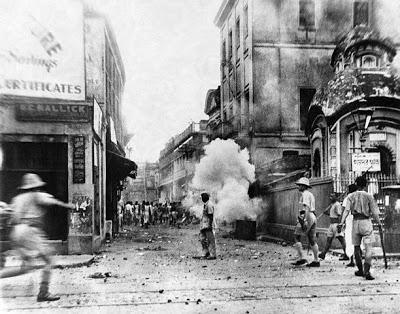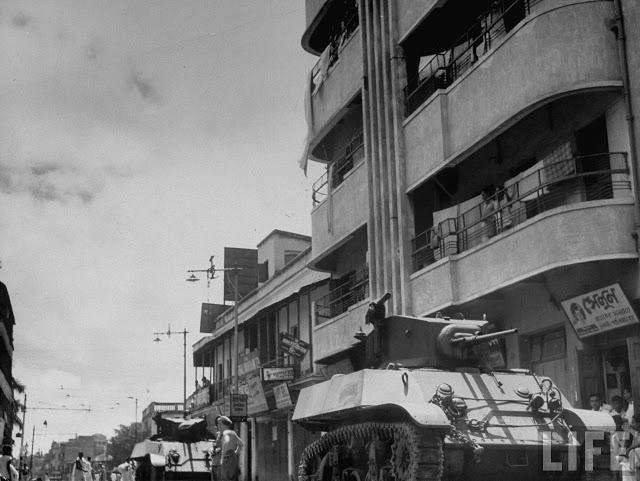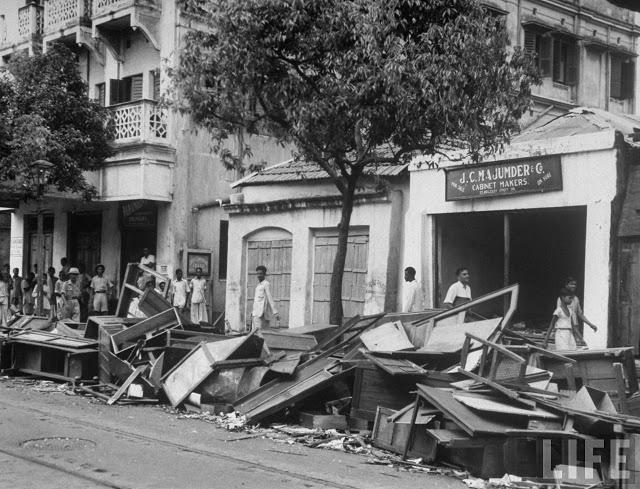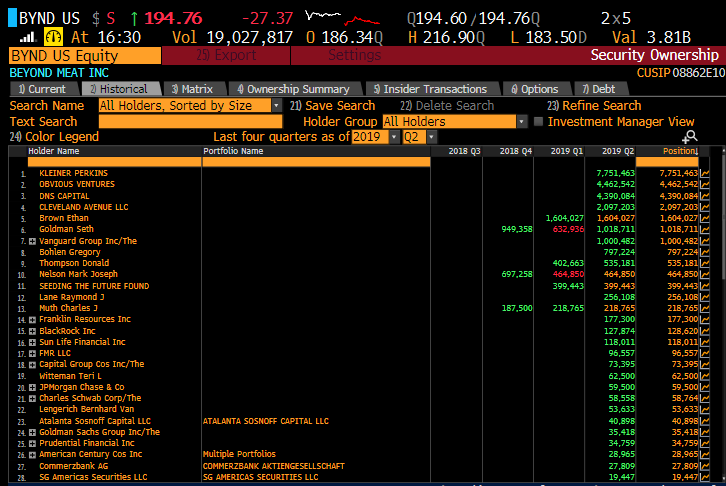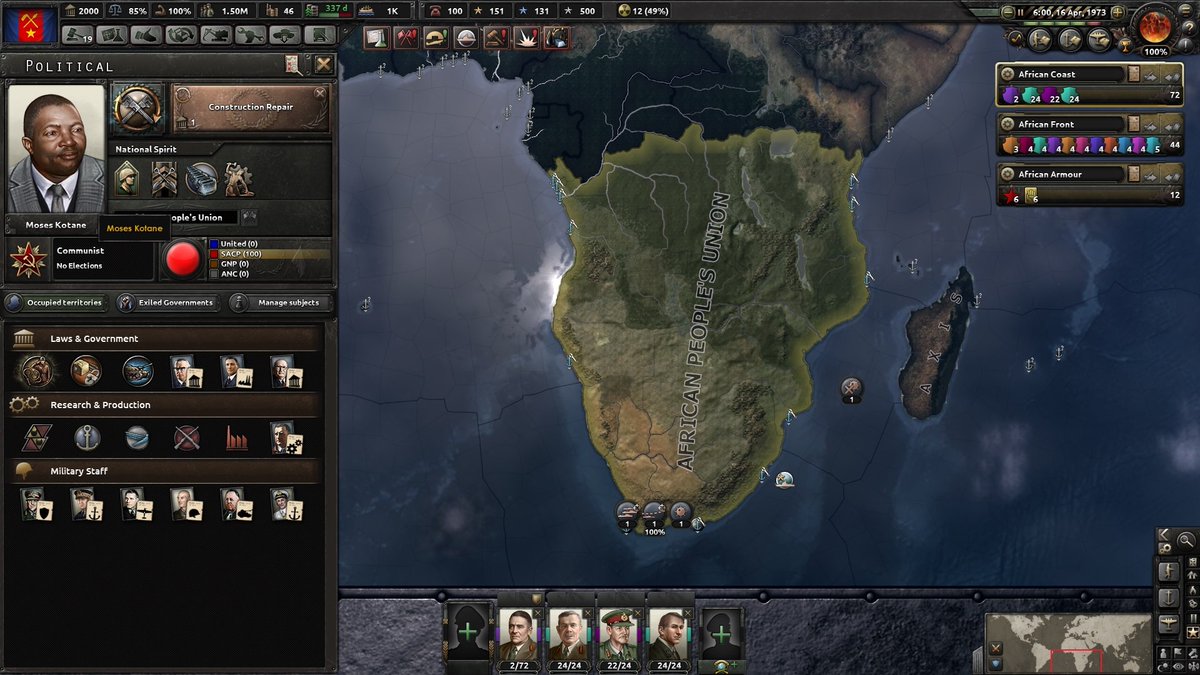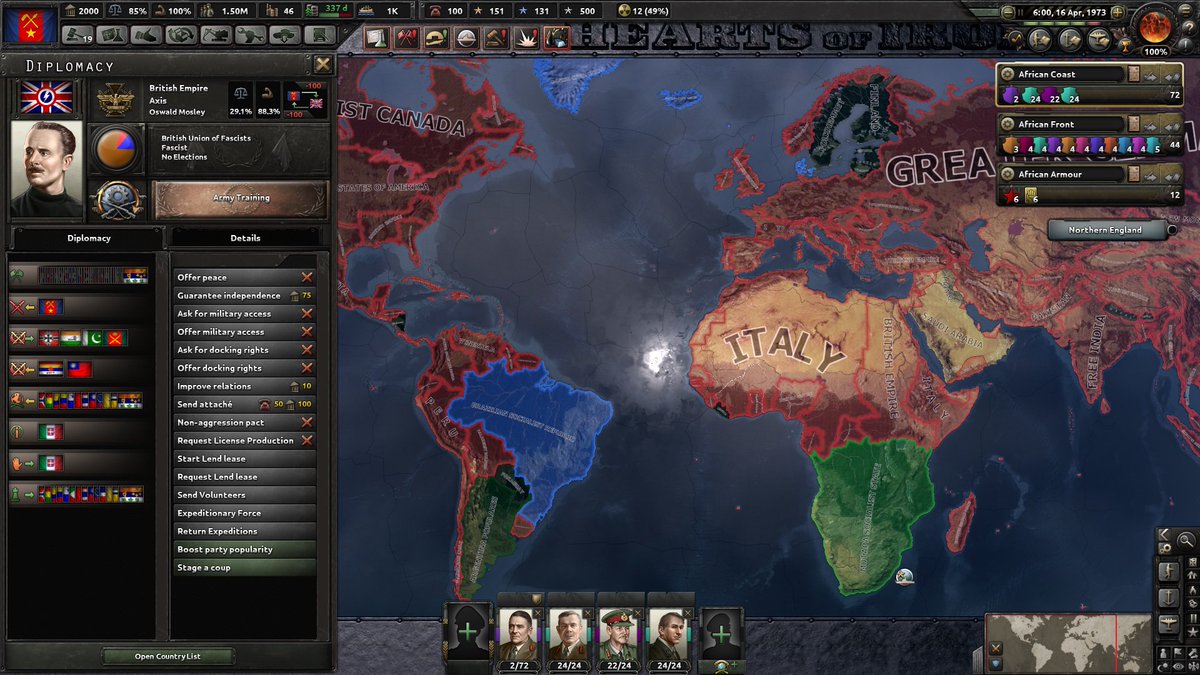HQ 80 Infantry Brigade had arrived in Chhamb. The initial task given to this brigade was to consolidate the positions in Chhamb and engage in limited mopping up ops in the area.
From 14-17 Dec, enemy would stage minor attacks everyday to avenge the defeat. However, 1 Patiala stood firm & beat them all back without much trouble.
Meanwhile in Uri, 6 RajRif were in process of taking over duties of 1 Sikh to enable them to reel back to Srinagar.
The Paltan had arrived a day earlier, under command Lt Col SS Kalaan, MC.
Their journey had its 'exciting' moments too when the enemy had opened up on its convoy with light machine guns on the outskirts of Uri.
However, he was silenced by the accompanying armoured escorts and the battalion reached Uri on the appointed day, though slightly delayed.
On the political front, the PM's views had undergone a radical change by now, hastened by the latest parleys in Lahore on 8-9 Dec.
The diplomatic breakthrough he had hoped for, had failed to materialize.
There was enough evidence at hand to conclude that Pakistani Govt was explicitly involved in equipping the 'raiders' and directing their ops.
To top it, defensive tactics employed by the army were to his liking.
The service chiefs maintained that throwing the enemy out wasn't possible before spring.
To top it, the PM had prevailed upon Governor General & his British Service Chiefs not to evacuate Poonch, with great difficulty.
Nehru concluded that the solution lay in striking at the invaders' concentrations & lines of communication INSIDE PAKISTAN.
He spelt out his views in an incisive political note in which he appraised India's military response thus far as having been unnecessarily defensive and apologetic, as if 'we were ashamed of what we were doing' & not sure of how far we must go.
He continued .. 'I see nothing to apologise for & a defensive way of meeting raiders seems to me completely wrong'.
The PM noted his dissatisfaction with own tactics so far that he felt had been unsuccessful.
'There is a certain heaviness of thought & action which is peculiarly unsuited to a conflict of the type we are waging.
We cannot go on carrying this little war for months and months and maybe a year or more.'
The PM concluded thus -
"Are we to allow Pakistan to continue to train new armies for invasion & allow its territory to be used as a base for these attacks? The obvious course is to strike at these concentrations & lines of communications in Pakistan territory.
From a military point of view this would be the most effective step. We have refrained from taking it because of political considerations.
We shall have to reconsider this position 'coz a continuation of the present situation is intolerable .. this involves a risk of war with Pakistan. We wish to avoid war, but it is merely deluding ourselves to imagine that we are avoiding war so long as the present ..
.. ops are continuing on either side"
In essence, here was the PM of a dominion hemmed in by 'forceful' advice of the Governor General tenanted this position for BOTH the warring sides, and the Service Chiefs on both sides too being British.
It would be foolish to believe that the UK would not orchestrate this war to atleast some extent in order to suit its own interests in the region that was so close to USSR.
Another factor that added to an apparent British 'bias' towards Pakistan was the belief that India was too 'multicultural' to survive long as a country while the glue of religion would bind Pakistan!
And events in the coming days would give credence to this theory when Mountbatten would successfully 'convince' Nehru on 20th Dec 1947 to drop this plan. (More on that five days later)
6 Raj Rif finally took over all duties and picquets of 1 Sikh, thereby allowing the latter to move to Srinagar to rebuild itself.
Brig LP Sen, Commander 161 Brigade wrote an appreciation of the current situation, presenting an excellent analysis of the situation & the prospects up ahead.
He considered various factors relevant to his object of forming a firm base at Uri in order to prevent raiders from entering the Valley.
Uri was strategically very imp since it dominated routes to Domel, Poonch & Srinagar.
It was surrounded by high mountains that needed to be held, in addition to the supply route from Srinagar.
In addition, Mahura too needed to be held due to the vital Power House over there.
As per Brig Sen, two main enemy thrusts were likely to be against the line of communication between Uri-Baramula & against Srinagar Valley from Handwara.
Although there were other routes leading into the Valley, including one from Gilgit, however they were blocked for the winter.
Same was the case with the route from Poonch to Srinagar via Gulmarg.
He estimated that approx 1500 hostiles were in Bhatgiran while smaller groups of about 500 were holding Dacchi, Kalgai, Churunda & Handwara.
Main enemy concentrations were in Garhi, Chakothi & Domel with total strength estimated to be 6000 men.
Brig Sen had 5 infantry battalions + 3 attached companies to meet this strength.
In addition, he also had one squadron of armoured cars.
He planned to have 2.5 battalions for defence of Uri, one for road Uri-Baramula with battalion HQ & 1 company at Rampur, 2 companies at Mahura & 1 company at Heman Buniyar.
This would enable the battalion commander to hold the approaches, vigorously patrol the road & have a company as reserve, while protecting Mahura.
Regarding Baramula proper, a battalion with 3 companies would be stationed there with the 4th company at Naushahra, covering any threat along the right bank of Jhelum & from Handwara.
As events unfolding in 1948 would prove, his assessment was to prove to be remarkably accurate regarding enemy plans and intentions!
Some days back Brig Usman had taken over command of 50 Para Brigade from Brig Paranjpe.
Under him, the Brigade was attempting to consolidate its positions at Naushera.
They had attacked Kot on 14 Dec but due to a well dug in enemy, failed.
Then on 16 Dec, the aggressive commander, Brig Usman had sent a column from Naushera to capture Chingas, while a feint attack was once again launched against Kot at 10 am.
The Chingas column was heavily engaged & held up at Ambli Dhar feature.
At the same time on 16 Dec, enemy had made repeated attempt to capture Tain Dhar, North of Naushera. He had attempted a number of attempts to assault the picquet holding it after subjecting it to a heavy volume of fire.
However, the picquet held on.
On 17th Dec, the column bound for Chingas continued its advance after an eventful day on 16th.
The enemy fire was relentless.
Undaunted, the column inched ahead on 18 Dec towards Kamila on a two company front.
The enemy fired heavily, using 2 bren guns & about 60 rifles.
Own troops kept advancing & finally reached Kamila at 10pm.
Meanwhile in Chhamb, 1 Patiala had beaten back enemy attacks mounted daily for the last 4 days.
On 18 Dec, 4 Rajput moved in to Chhamb to relieve 1 Patiala.
1 Patiala, less 2 companies, moved to Akhnur. 'A' & 'B' Companies & a section of 3-inch mortars continued to remain in Chhamb, coming under command 4 Rajput for the recapture of Munawwar that was planned the next day.
In Delhi, Mountbatten learnt of Nehru's new thought process (refer tweet quoted below) upon returning from a tour of Jaipur & Bombay.
He was alarmed at the imminent prospect of open war between the two dominions, something he had striven hard to avert.
Not only would such a war be a setback to the British Commonwealth, but at a personal level, also raise questions about his continuing to hold the office of Governor General of India.
He had claimed earlier that 'he was the best insurance against an actual outbreak of war with Pakistan'.
What he failed to realize was that India was ALREADY at war with Pakistan, and continues to be so even today, after 72 years ..
Having failed to bulldoze Nehru into making unilateral concessions to Pakistan in return for practically nothing in return, he seemed to have come round to the conclusion that the UN was the only viable option left to prevent an open war.
This is why he had proposed, at the end of Sep 1947, that the Junagarh issue too be referred to the UN. In Nov, when he met Jinnah, he'd proposed the same for J&K too.
It does seem 'intriguing' to note, with benefit of hindsight no doubt, that all his solutions to 'avoid a war' actually amounted to seeking to accommodate Pakistan's 'concerns' while asking for repeated concessions from Nehru - a policy that has survived to this day.
4 Rajput advanced from Chhamb towards Munawwar. Upon seeing them approach, the enemy withdrew across the IB to Pakistan territory.
50 Para Brigade too, moved ahead of Kamila.
'B' & 'C', the forward Companies moved out in North East direction & captured point 4622.
With the Kashmir Valley snowed in, Jammu area saw the most fighting these days. 80 Brigade & 50 Para Brigade were each advancing and 268 Brigade was tasked to guard the supply routes.
However, proximity of most roads to the IB meant that 268 Brigade too had its fair share of 'excitement'.
2 Jat was on line of communication duties on Jammu-Sialkot, Jammu-Srinagar & Jammu-Naushera roads, with Battalion HQ & 'A' Company at Chauki.
At 4:30pm on 19 Dec, a wireless message was received from Beri Pattan, informing 2 Jat HQ at Chauki that a convoy proceeding from Beri Pattan to Akhnur had been attacked West of Sadhot.
Hereafter, it was decided to clear the enemy from Sadhot and secure the route once and for all. This would be done on 20 Dec 1947
The plan for a company attack on enemy position at Sadhot was to be carried out in 2 phases.
In Phase 1, a platoon would advance from Twin Knobs along the Kali Dhar ridge at 7am on 20 Dec & 2 platoons + mortars would move in vehicles.
Both columns would meet at milestone 34.
In 2nd phase, 'A' Company + a detachment of mortars would move alongside the road to Sadheri, wherefrom they would capture Sadhot.
On the appointed hour, a platoon advanced along the Kalidhar Ridge while rest of the company moved in vehicles, debussing at Milestone 34.
They advanced towards Sadheri & married up with the 1st platoon, coming under intense fire from hills dominating the narrow road.
The hills were steep & extremely difficult to climb from the road.
Own troops had just started returning fire when they suddenly came under fire from the nala on the other side of the road as well.
They had been ambushed & were encircled.
At about 9:45, about 200 strong enemy attacked the Jats with all that they had. The men of 2 Jat battalion fought back with grim determination, refusing to oblige the enemy.
The battalion hung on. The forward platoons on the left came under particularly heavy fire. The officer commanding the platoon, however rushed at the enemy & threw a grenade from mere 9 metres from him, getting seriously wounded in the process.
His second in command took over & threw another grenade, waiting 2 seconds after pulling the pin before throwing it, making sure it wasn't thrown back at him.
The rest of the men emulated their leaders & held their ground.
When the platoon started running short of ammunition, a Lance Naik was ordered to go back and fetch some from the ammo truck parked behind on the road, which was under heavy sniper fire.
Two men had already been wounded trying to get ammo from the truck.
Regardless, the Lance Naik rushed to the truck & succeeded in reaching it unharmed. He threw a few ammo boxes out of the truck on the ground & jumped out.
But it was a difficult job to get the ammo to the platoon due to enemy snipers waiting for him.
He however took cover, broke the boxes and started throwing bandoliers of ammunition towards his comrades. Though he was wounded, he managed to get ammunition to the men.
As the forward platoon was pinned down by enemy fire, it was necessary to get them to a more favourable position.
Thus, at midday another platoon was ordered to go up the hill from the left.
It brought down effective light machine gun fire on the enemy, thus enabling the forward platoon to extricate itself.
Now came the question of sorting out the enemy.
There was only one small field where a 3-inch mortar could be deployed, but it was under enemy fire from a hill nearby.
Regardless, a Naik volunteered to put the mortar in position in the field. A bullet went thru the ammunition & another two hit the barrel of the mortar. Undaunted, he managed to bring the mortar into action & kept up a steady barrage on the enemy.
In the middle of this, the company sent an SOS to the battalion tactical HQ at Chauki at about 11:15 am.
A Lieutenant of 3 Platoon Para Supplies of 50 Para Brigade, who happened to be at Chauki enroute to Naushera, volunteered to assist the 'A' Company. At 12:30 pm he was sent up along with a platoon formed out of HQ and administrative personnel.
He reached the scene of the action at about 4 pm. At about 6:30 pm, CO 2 Jat also reached with a company of 1/9 Gorkha Rifles.
This proved decisive. The enemy withdrew from the battlefield.
His ambush had failed.
Enemy was thought to have suffered 40 killed & 70+ wounded.
Own casualties were 7 killed & 14 wounded.
Patrols next day would report the area clear of enemy.
Meanwhile, the Chingas column of 50 Para Brigade returned to Naushera due to insufficient strength.
The column reached Naushera at about 3pm. It brought back 9 abducted women & 8 Hindu men that it had rescued over the last few days.
However, Jhangar was still under sustained enemy pressure for the last week.
A day prior, on 19 Dec, enemy had demolished a bridge on Naushera - Akhnur road.
When the convoy got held up, about 300 enemy assaulted.
The last vehicle of the convoy turned back to Beri Pattan & reported the incident. A platoon of 3(Para) Rajput rushed to the spot when the fight was still going on.
The column was extricated and brought back. Indian casualties were 1 officer & 16 other ranks missing.
In addition, a picquet of 1/2 Punjab at Jhangar saw a strong enemy attack last night (19 Dec) at 9 pm, supported by heavy mortar fire. The attack was repulsed after a fierce firefight that lasted 6 1/2 hours till 3:30 in the night.
However, the enemy would keep up the pressure on Jhangar, successfully capturing it on 24 Dec.
Meanwhile in Delhi, Mountbatten put into action his plan to scuttle Nehru's intentions to widen the scope of the conflict.
Matters came to a head in the meeting of Defence Committee of Cabinet on 20 Dec.
The PM began by describing the overall situation as unsatisfactory and unacceptable.
He observed that a regular war was being waged in Indian territory from bases inside Pakistan territory. This situation couldn't be allowed to continue indefinitely.
It was necessary, Nehru said, to be clear about possible developments which might result from a political decision to conduct a limited strike inside Pakistan.
This might mean Indian forces having to enter the districts of Sialkot, Gujrat & Jhelum in order to deny 'raiders' the assistance they'd been getting from bases over there.
From an operational angle, he asked the Service Chiefs to view Kashmir & West Punjab as a single area of operations.
Mountbatten interjected, saying that he didn't consider this ought to be issued as a directive to the Service Chiefs.
The PM didn't contest this but insisted that it was essential that the Defence Committee should commence a study of this contingency.
Mountbatten argued that the proper course would be to refer the matter to the UN. He said that India had a solid case & said, disingenuously, that UN would promptly direct Pakistan to withdraw the raiders.
Faced with the Governor General's non-cooperation, Nehru reluctantly agreed to a compromise. He agreed to refer the matter to the UN, even while instructing Service Chiefs to plan for a full fledged war as a contingency
Yet, he was not convinced that the UN would be of much help.
He wrote to General Bucher:-
"We shall naturally continue our efforts in political field, by reference to UN, to bring about some cessation of fighting if possible. But I am sure that ..
.. this will not result in fighting stopping at present. Indeed there is every chance of its spreading more & endangering our security. We have thus to be prepared for every contingency & to be prepared soon."
The Cabinet met on 20 Dec itself after the Defence Committee session. Nehru presented the proposal for requesting the UN to call on Pakistan to cease its aggression in Kashmir.
In presenting the request, however, India would also make it clear that she reserved her right to take appropriate measures in self defence.
Before approaching UN, India would formally request Pakistan govt to stop giving aid or encouragement to the 'raiders'.
These proposals were approved by the Cabinet.
In addition to making preparations for a counter attack by the Indian Army, the Cabinet also envisaged raising a substantial force of irregulars, both in Kashmir & Punjab, for guerilla warfare & 'frontier patrol' purposes, thus taking a leaf out of the Pakistani book
The irregulars were to be raised by political leaders but they would function under the general guidance of the army commanders. In Kashmir, Bakshi Ghulam Mohammed was given the responsibility to raise the force.
The 2 Jat men at Sadhot were further reinforced by another company ex 1/9 GR in addition to the one that had arrived last evening.
The reinforcements arrived at about 1 in the afternoon. However, there was no enemy activity in the area the entire day.
Patrolling by men of 2 Jat revealed that the enemy had vacated the area of Sadhot for good after the unsuccessful ambush there.
Meanwhile, across the Pir Panjal, 6 Raj Rif had completed the relief of 1 Sikh which was sent back to Srinagar to recuperate from the losses incurred in Bhatgiran.
However, one company was retained at Baramula.
The Srinagar Garrison was dissolved & Col Harbaksh Singh assumed command of the unit, in addition to carrying out the duties of Station Commander, Srinagar.
Even though a road link up with Poonch was unavailable, however Dakotas had been landing there for over a week now, from 13 Dec.
Brig Pritam Singh, Commander Poonch Brigade, had decided to expand the Poonch airstrip to enable Dakotas to land.
To achieve this, he had utilized the voluntary services of hundreds of refugees who had worked hard to complete the work.
On 12 Dec, a Dakota on a supply drop at Poonch was shot up from the hills to the West of Poonch. However, it had managed to land safely at Poonch.
On 13 Dec, another Dakota landed at Poonch, bringing with it a section of guns of Mountain Battery.
The arrival of these guns eased the situation a good deal, for the enemy was compelled to withdraw his mortars out of their range & shelling on Poonch town stopped.
Hereafter, Dakotas would operate at Poonch continuously, bringing much needed supplies & evacuating the wounded.
Such was the spirit & commitment of the RIAF boys that even when Jammu airfield was made inoperable due to rains, they would mount sorties from Amritsar instead, keeping the air bridge to Poonch operational at all costs.
That Poonch successfully defied all attempts by enemy to capture it is also due to the pivotal role played by the RIAF in keeping it supplied.
22 Dec also saw an inter-dominion conference.
Nehru handed over a letter to Liaqat Ali Khan to 'formally ask the Govt of Pakistan to deny the raiders:
(i) Access to use of Pakistani territory for ops against Kashmir;
(ii) All military & other supplies;
(iii) all other kinds of aid that might tend to prolong the present conflict'.
By now it was clear that the enemy was preparing to attack Jhangar in strength.
He had been sending small parties at night to 'feel' the Indian defences.
His coordination & planning for the final attack was near perfect.
After these preliminary ops, he cut off the line of communication before launching the main attack on Jhangar.
This was done in form of strong road blocks on Jhangar-Naushera and Beri Pattan-Chauki roads.
On the morning of 23 Dec 1947, No 2 troop of the armoured squadron escorting a convoy carrying rations, ammo & a company of 1 Rajput from Naushera to Jhangar encountered one such road block about 6 km West of Naushera, coming under heavy fire from hills North and ..
.. South of the road at about 10 am.
No 1 troop of the squadron proceeding from Jhangar towards Naushera also encountered a similar road block at about same time.
Both columns got involved in very heavy fighting.
Enemy in this area was approx 1500 strong, armed with mortars, light machine guns, rifles & hand grenades. He succeeded in blowing up 2 bridges in rear of each column, cutting off routes of withdrawal.
Now there were 4 road blocks, keeping the 2 troops of armoured cars about 900m apart.
At 4 pm, 1 Rajput less a company arrived in the area and attempted to retrieve the situation.
They too, however, got involved in heavy fighting & were unsuccessful in bringing back the armoured cars due to the broken bridges, though they extricated their own company caught up in the ambush by 6 pm.
The company commander was wounded, 3 jawans killed & 3 were missing.
Meanwhile the armoured cars were still locked up in a fierce fight with the enemy on the road blocks.
All 4 valiant crews fought all day and night.
Jemadar Umrao Singh, leader of No 2 troop, rallied the men & together they repulsed at least 6 determined attacks by enemy on 23 Dec & night 23/24 Dec, though enemy anti tank rifles damages the armoured cars considerably.
Here one must take a moment to admire the the 'resourcefulness' of NON STATE ACTORS ex Pakistan who, even in 1947, had managed to 'procure' anti tank weaponry at such a short notice!
Yes, there was no way that the Govt, or the army of Pakistan was involved in the war - just those fiercely independent tribals!!
Jhangar fell this day.
Having successfully blocked Naushera - Jhangar road & preventing reinforcements, enemy attacked Jhangar in great strength.
The first attack came in from South West at about 6.30 am with a force of about 2000.
The weak company holding the position on Pir Matalsi ridge, without even a barbed wire fence in front, was soon overrun by the enemy.
The machine gunners kept up a steady wall of fire, but were cut to pieces while still firing their guns.
Despite large casualties, the enemy had captured the Pir Matalsi Ridge an hour after attacking it.
The company to its flank was dominated by the Pir Matalsi Ridge. It too fell shortly thereafter.
By daylight, whole of the ridge was in enemy hands.
The second attack came from the North West at 7.30 am.
With the vital Pir Matalsi Ridge in enemy hands, remnants of the other two companies were put on the small local features on the cross roads, but they couldn't hold back the enemy.
Jhangar was now completely surrounded, cut off from Naushera.
Inter-communication with Naushera was disrupted at about 7.40 am.
Mortar ammo too, was exhausted & the enemy had occupied the intermediate features between the cross roads & Pir Matalsi Ridge.
The Jhangar Garrison Commander now had two choices before him - Either hold on and get completely annihilated, or withdraw to Naushera.
He decided upon the latter course of action.
All available vehicles were loaded & dispatched, only to be lost at the roadblocks.
Remnant personnel too began trickling towards Naushera in small parties.
Meanwhile, armoured cars at the roadblocks too had recommenced their battle with the enemy at about 7 am. Their ammo was very nearly exhausted, however No 1 troop (ex Jhangar) had managed to join up with the No 2 troop.
They moved on towards Naushera when, immediately after passing over a bridge, the wheel of the leading armoured car slipped off the road. The second armoured car attempting to retrieve it also got ditched.
The crews finally abandoned their armoured cars after nearly 36 hours of battle at noon and walked back to Naushera by 2 pm.
The troop leaders still attempted to recover the armoured cars using a breakdown lorry, but were unsuccessful.
However, guns were removed from them & brought back by 6 pm.
During the desperate struggle to hold on to Jhangar earlier in the day, an attempt was made to send a relief column from Naushera.
1 Rajput, less a company, a section of mountain arty and a section of medium machine gunners left Naushera at about 7 am.
In order to avoid enemy on the road, they moved South of it. However, they were held up about 3 km South West of Naushera by an enemy force occupying a strong position on and around Nothi Dhar for just such a contingency.
A savage battle raged throughout the day but own troops couldn't get through since the enemy was in well sited positions, dominating own route.
However, one small consolation for this column was that when the defenders of Jhangar arrived their way after withdrawing, they were able to help them reach Naushera. After darkness fell, this column broke contact & withdrew to Naushera.
The loss of Jhangar was a serious setback. Indian casualties in men and material were heavy.
2 officers & 51 other ranks died, 2 JCOs & 58 other ranks were wounded & 42 other ranks were reported missing.
Equipment lost included five 3-inch mortars, twelve 2-inch mortars, 4 medium machine guns, 14 light machine guns, 70 rifles, 4 armoured cars & a number of other vehicles.
The tragic story of loss of Jhangar is, however, illuminated by the reckless heroism of a handful of machine gunners of 1 Mahar who invariably found themselves in the forward defences in order to maximize the effect of the machine guns, or to vulnerable flanks.
Due to the very nature of their equipment & their locations, they were given special 'attention' by the enemy since they took a heavy toll of the enemy by relentless fire.
However, they refused to budge from their designated positions, choosing instead to keep killing the 'tribals' till their very last moments when they were overrun and cut to pieces.
These men truly epitomized the soldier of the army of the newborn Republic of India, deciding to stay put on the land that was now theirs, even if it was a 1000+ miles from their homes.
It would take another special kind of leader to retrieve this land where they died - Brig Mohammad Usman, who too would fall in the process.
But that day was still a few months ahead.
For the time being, however, Jhangar lay trampled beneath the feet of the enemy.
The enemy followed up the previous day's success at Jhangar with an attack on Naushera at 6 pm by approx 3000 raiders.
Naushera garrison was completely surrounded.
Parties of enemy also bypassed Naushera & moved towards Beri Pattan to cut off the line of communication & route of reinforcement.
The camp was also heavily mortared.
The enemy made 2 attempts to infiltrate the camp at 7pm & 9pm. Both attempts were foiled.
Several enemy attempts to rush the picquets were also repulsed.
This carried on throughout the night.
One factor favouring the Indian side was the weather during the day which permitted the RIAF to fly a large number of sorties, something it was unable to do on 24 Dec when Jhangar had fallen.
Own Tempests flew unhindered, strafing/bombing ammo dumps & enemy concentrations. This undoubtedly blunted the edge of further enemy attacks.
Meanwhile, Mountbatten, who was deeply concerned over possibility of an Indian counter attack, wrote a long missive to Nehru on Christmas Day, 1947.
The letter, which ran into 2000 words, repeatedly emphasised that Mountbatten's consistent policy had been to stop the hostilities. He recalled his consistently opposed extension of the fighting to the western areas of the state in Poonch & Mirpur & complained ..
.. about the ops carried out in these areas in Nov, during his absence in London. He stressed his assessment that chance of clearing Poonch of hostiles was remote. (That the Indian Army still did it a few months later was a different matter altogether!).
Coming to his main point, Mountbatten expressed his concerns over the proposal to strike at tribals' bases / nerve centres inside Pakistani territory, hinting at international pressures.
He warned Nehru that 'the idea that a war between India & Pakistan could be confined to the sub continent, or finished off quickly in favour of India without further complications, is to my mind a fatal illusion.'
In very clear words, the British appointed Governor General had issued a warning to Indian PM that any such action would invite international intervention!
Finally,Mountbatten pitched for involving the UN 'at the earliest & get a team nominated to deal with the business & help stop the fighting, within a matter of days'
In effect, his missive to Nehru was an urgent appeal to stop the fighting ASAP & knock the doors of UN
Nehru sent a vigorous reply to Mountbatten's 'missive' received by him a day earlier.
He wrote, "The invasion of Kashmir is not an accidental affair resulting from the fanaticism or exuberance of the tribesmen, but a well organised business with the ..
.. backing of the State .. we have in effect to deal with a State carrying on an informal war, but nevertheless a war. India had thus far followed a 'cautious defensive policy' which had presented Pakistan with an advantage.
By carrying on ops in a 'weak defensive way' India couldn't produce an effective impression on the adversary. From a strictly legal & constitutional point of view, it is our right & duty to resist this invasion with all our forces.
From the point of view of international law we can in self-defence take any military measures to resist it, including sending our armies across Pakistan territory to attack their bases near the Kashmir border.
Peace will come only if we have the strength to resist the invasion & make it clear that it will not pay."
Nehru continued, "The Govt of India had accepted Mountbatten's suggestion & would make a reference to the UN but it cannot ask the UNO to arbitrate between raiders & the Dominion of India or to make a joint reference with Pakistan on mutually agreed lines.
India, as the aggrieved party, would draw the attention of UN to call upon Pakistan to refrain from aiding & abetting the invasion of Kashmir.
Meanwhile, India must prepare for any eventuality.
'We have ..
.. taken enough risks already; we dare not take any more. We can't even permit much longer the continuation of the use of bases in Pakistan to attack our troops & our territory in Kashmir. There is no question of small ops going on in Kashmir thru the ..
.. winter months, but of quick developments.'"
The PM concluded that the Govt immediately proceed on 2 parallel lines of action -
1. Reference to the UN, and
2. Complete military preparations to meet any possible contingency that may arise. If grave danger ..
.. threatens us in Kashmir or elsewhere on the West Punjab frontier, then we must not hesitate to march thru Pakistan territory towards their bases."
The Governor-General's Christmas Day letter, however, was intended as much for Attlee's eyes as Nehru's.
Full text of the letter, alongwith extracts from Nehru's reply & relevant minutes of the Defence Committee meeting, were passed to London thru top secret cables from the UK High Commissioner. Mountbatten's intention was to put on record his own role ..
.. in restraining the Indian Cabinet and to inform Attlee of India's plans.
His 'anxieties' had been heightened by the latest developments on the military front. Immediately after the loss of Jhangar.
He asked High Commissioner Shone to pass the following message to Attlee - "Mountbatten's considered opinion is that the situation between Indian & Pakistan has reached ..
.. a pitch where war will supervene within a very short while unless immediate action is taken .. Main factor producing this is imminent danger that Indian troops will suffer major military defeat in Kashmir on Uri & Naushera fronts.
If this occurs, nothing that Mountbatten can do will prevent Indian forces from marching in to West Pakistan to take possession of what Nehru calls 'bases & nerve centres of raiders'.
In a way, this betrayed the fact that Mountbatten might already have ..


